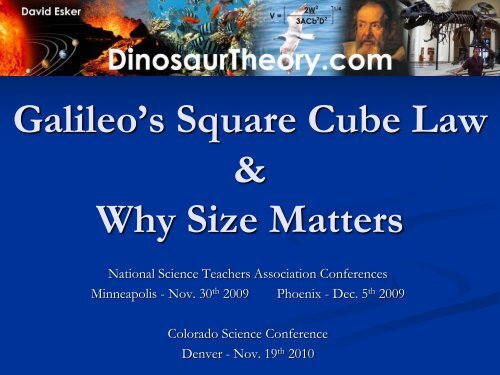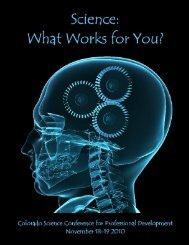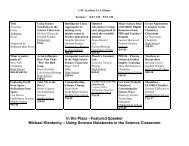Galileo's Square Cube Law - Colorado Association of Science ...
Galileo's Square Cube Law - Colorado Association of Science ...
Galileo's Square Cube Law - Colorado Association of Science ...
You also want an ePaper? Increase the reach of your titles
YUMPU automatically turns print PDFs into web optimized ePapers that Google loves.
Galileo’s <strong>Square</strong> <strong>Cube</strong> <strong>Law</strong><br />
&<br />
Why Size Matters<br />
National <strong>Science</strong> Teachers <strong>Association</strong> Conferences<br />
Minneapolis - Nov. 30 th 2009 Phoenix - Dec. 5 th 2009<br />
<strong>Colorado</strong> <strong>Science</strong> Conference<br />
Denver - Nov. 19 th 2010
The New <strong>Science</strong><br />
• In 1638 Galileo published<br />
Two New <strong>Science</strong>s.<br />
• Because the ratio between<br />
area and volume changes<br />
with size, size matters.<br />
• Galileo’s <strong>Square</strong>-<strong>Cube</strong> <strong>Law</strong><br />
is one <strong>of</strong> the most<br />
fundamental concepts in<br />
all <strong>of</strong> science.
<strong>Science</strong> Gone Wrong<br />
• Yet 3 & ½ centuries later<br />
Galileo’s <strong>Square</strong>-<strong>Cube</strong><br />
<strong>Law</strong> is still being left out<br />
<strong>of</strong> science education.<br />
• Consequently most<br />
everyone is still unsure if<br />
size matters.
Does Size<br />
Matter?<br />
•It is a major failure <strong>of</strong> science<br />
education that our society is<br />
ignorant regarding this extremely<br />
fundamental scientific question.
Misleading Experts<br />
• Giant dinosaurs and pterosaurs appear to<br />
conflict with Galileo’s <strong>Square</strong>-<strong>Cube</strong> <strong>Law</strong><br />
showing that size matters.<br />
• Either 1) Galileo’s <strong>Square</strong>-<strong>Cube</strong> <strong>Law</strong> is<br />
wrong or<br />
• 2) the paleontologists claiming that there<br />
is nothing odd about giant dinosaurs and<br />
pterosaurs are wrong.
The evidence supporting Galileo’s<br />
<strong>Square</strong>-<strong>Cube</strong> <strong>Law</strong> is overwhelming.<br />
• Problem: The ‘experts’ are never<br />
going to admit to being wrong.<br />
• <strong>Science</strong> educators have an<br />
obligation to be leaders in<br />
determine what is good science.
What is Galileo’s<br />
<strong>Square</strong>-<strong>Cube</strong> <strong>Law</strong><br />
• The area is the<br />
square <strong>of</strong> the length<br />
multiplier.<br />
• The volume is the<br />
cube <strong>of</strong> the length<br />
multiplier.<br />
• Changing the size<br />
changes the ratio <strong>of</strong><br />
area to volume.<br />
Height<br />
Depth<br />
Width
Scaling Example <strong>of</strong> <strong>Square</strong>-<strong>Cube</strong> <strong>Law</strong><br />
• If kite B is three times<br />
taller than kite A.<br />
• Then kite B has nine<br />
times the surface area <strong>of</strong><br />
kite A; yet it weights 27<br />
times more than kite A.<br />
• Will kite B fly if its<br />
weight to area ratio is<br />
three times greater?<br />
Kite A<br />
Kite B
Larger flying objects require<br />
disproportional greater power.<br />
Applies to planes, helicopters, birds, and<br />
other flying animals.
Consequences <strong>of</strong><br />
Scaling are not<br />
Always Obvious.<br />
• Simple objects may still work when they<br />
are scaled up or down.<br />
• Yet complicated objects such as flying<br />
machines and biological objects will<br />
usually fail if their size is outside their<br />
normal narrow range.
Consequence <strong>of</strong><br />
being ignorant <strong>of</strong><br />
the Galileo’s<br />
<strong>Square</strong>-<strong>Cube</strong> <strong>Law</strong>.
Galileo’s <strong>Square</strong>-<strong>Cube</strong> <strong>Law</strong> Applies<br />
to All <strong>Science</strong> Disciplines<br />
• Aerodynamics<br />
• Biology<br />
• Nanotechnology<br />
• Astronomy<br />
• Physics<br />
• Chemistry
Smaller objects<br />
have more<br />
exposed area.<br />
• Small grains,<br />
powders, gives us<br />
the c<strong>of</strong>fee that we<br />
want FAST!<br />
• The small sticks<br />
exposed more wood<br />
at the surface for<br />
burning.
Rate <strong>of</strong> Heat Transfer<br />
• Food with large areas compared to their volume<br />
cooked in only a few minutes.<br />
• Food with a large volume compared to its surface<br />
area require a few hours in the oven.
Larger Size Objects have:<br />
• Greater difficulty achieving flight<br />
• Greater stress so large objects are<br />
more likely to break<br />
• Slower chemical reactions.<br />
• Lower heat transfer.
Galileo’s <strong>Square</strong>-<strong>Cube</strong> <strong>Law</strong> is fundamental<br />
to understanding biology.
Diffusion Rates / Cell Division<br />
• Cells need a high surface<br />
area to volume ratio to<br />
be efficient in passing<br />
food and waste across<br />
the cell membrane.<br />
• Larger cells have a lower<br />
surface area to volume<br />
ratio.<br />
• So cells divide rather<br />
than grow larger.
Stress & Bad Health <strong>of</strong> Giants<br />
• Stress on Robert<br />
Wadlow’s legs is about<br />
twice that <strong>of</strong> the girls.<br />
• Likewise his difference in<br />
blood pressure with<br />
height is about twice that<br />
<strong>of</strong> the girls.<br />
• Giants and overweight<br />
people tend to suffer<br />
numerous health<br />
problems.
Something has got to give!<br />
• If you double the size <strong>of</strong><br />
an animal then<br />
• 1) Weight is eight times<br />
greater while<br />
• 2) Supporting area is<br />
only four times greater.<br />
• Stress is twice as much<br />
and so the legs are more<br />
likely to break.
Larger Animals are More Likely to<br />
Break Bones<br />
• Small animals can fall great heights without harm.<br />
• Conversely, horses <strong>of</strong>ten break their bones while simply<br />
running a race.
• Elephant has the greatest absolute<br />
strength yet the least amount <strong>of</strong><br />
relative strength.<br />
• The smallest animals have the<br />
greatest relative strength.<br />
• Rhinoceros beetle can lift 850<br />
times its own weight.<br />
Strongest Animal:<br />
Absolute Strength<br />
and Relative<br />
Strength.
Relative Power Effects How Birds Fly<br />
• The humming bird has so much relative<br />
power that it can hover and even the fly<br />
backwards.<br />
• The largest birds <strong>of</strong>ten need rising air<br />
thermals to assist them with their flight.
When birds get too large they can<br />
no longer fly
Relative Power<br />
& Metabolism<br />
• Heaviest flying bird = 25 pounds.<br />
• Heaviest bat = 2.5 pounds.<br />
• There are no modern day flying reptiles.<br />
• Reason: birds have greater relative power<br />
• 1) superior circulating respiratory system,<br />
• 2) higher body temperature.
Smaller Mammals have<br />
Greater Heat Lost<br />
• Small mammals have to eat<br />
constantly to replace their lost<br />
thermal energy.<br />
• A five ton elephant will eat<br />
about 130 kg <strong>of</strong> food per day<br />
• Five tons <strong>of</strong> mice will eat 720<br />
kg <strong>of</strong> food per day.
Humans<br />
change their<br />
shape as they<br />
grow<br />
• As warm-blooded animals grow the surface to<br />
volume ratio decreases.<br />
• Effects the rate <strong>of</strong> heat transfer.<br />
• Babies have more rounded features and<br />
disproportionally large heads.
Larger Animals have:<br />
• Lower relative muscle strength<br />
• Greater stress on their bones so their<br />
bones are more likely to break<br />
• Less relative heat lost so larger animals<br />
eat proportionally less food<br />
• Lower heart rate.
The Biology Revolution<br />
• The new biology requires a foundation in<br />
mathematics and physics.<br />
• Education reform: physics first.<br />
• No real understanding until you write an<br />
equation or make a hypothesis.<br />
• Simply because something is alive does<br />
not excluded it from the laws <strong>of</strong> physics.
Size & Heart Rate<br />
• Smallest animals have<br />
much higher heart rates.<br />
• Mouse: 500 beats/min<br />
• Human: 70 beats /min<br />
• Elephant: 28 beats / min<br />
• Heart rate to body mass:<br />
R = (K m) -1/4 .
Biological Clock<br />
• Cells are like engines: their metabolism rate is<br />
directly related to the food and oxygen supply.<br />
• Circulating system <strong>of</strong> smaller systems delivers<br />
food and oxygen to cells at a higher rate.<br />
• Lifespan is about a trillion heart beats.
Further Reading<br />
• Scaling: the Physics <strong>of</strong> Lilliput - Morrison<br />
• A Matter <strong>of</strong> Scale - Ge<strong>of</strong>frey West<br />
• Scaling: Why Giants Don’t Exist - Fowler<br />
• On being the Right Size - J. B. S. Haldane<br />
• DinosaurTheory.com – David Esker
End <strong>of</strong> Presentation on<br />
Galileo’s <strong>Square</strong>-<strong>Cube</strong> <strong>Law</strong><br />
Thank you<br />
David Esker





